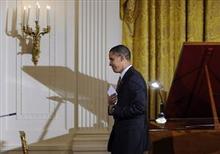So here’s how the evening of classical music at the White House went. President Obama  warmed up the crowd with remarks about not knowing when to applaud, eliciting laughs, according to the transcript provided by the White House.
warmed up the crowd with remarks about not knowing when to applaud, eliciting laughs, according to the transcript provided by the White House.
Now, if any of you in the audience are newcomers to classical music, and aren’t sure when to applaud, don’t be nervous. (Laughter.) Apparently, President Kennedy had the same problem. (Laughter.) He and Jackie held several classical music events here, and more than once he started applauding when he wasn’t supposed to. (Laughter.) So the social secretary worked out a system where she’d signal him — (laughter) — through a crack in the door to the cross-hall.
Now, fortunately, I have Michelle to tell me when to applaud. (Laughter.) The rest of you are on your own. (Laughter.)
I couldn’t watch it, because of another engagement, but The Washington Post‘s Anne Midgette did, and seemed to share concerns similar to mine: “The day’s message was, “Look, classical music can be fun,” even though this message is also a tacit admission of the widespread assumption that it isn’t.”
Earlier in the day, Michelle Obama had “sold” classical to kids by saying it was exciting because it could be changed. Midgette posted on my post, which asked whether the First Lady was thus sending the right message, partly agreeing without saying what I was questioning…but happy that classical music is being played in the White House.
The New York Times, meanwhile, suggested the importance of classical music by sending music critic Anthony Tommasini down to Washington to review it — in contrast to practice with the country, jazz and Latin events, when D.C. bureau people wrote about it or no one did. Rather a waste, I think: Tommasini offered no commentary, simply playing it straight.
